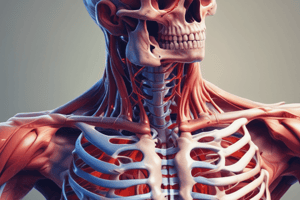Podcast
Questions and Answers
What is the primary function of bones in the human body?
What is the primary function of bones in the human body?
- To store essential minerals like calcium and phosphorus
- To provide a framework for the muscles to attach and enable movement
- To protect vital internal organs from external damage (correct)
- To produce new blood cells through hematopoiesis
Which type of bone is responsible for the anterior portion of the skull?
Which type of bone is responsible for the anterior portion of the skull?
- Irregular bones
- Short bones
- Long bones
- Flat bones (correct)
What is the primary organic component of bone structure?
What is the primary organic component of bone structure?
- Water
- Chondrocytes
- Mineral crystallites
- Collagen fibers (correct)
Which cellular element in bone structure is responsible for the formation of new bone tissue?
Which cellular element in bone structure is responsible for the formation of new bone tissue?
What is the primary role of bones in the process of hematopoiesis?
What is the primary role of bones in the process of hematopoiesis?
What is the primary function of the $ heta$ angle in the analysis of joint biomechanics?
What is the primary function of the $ heta$ angle in the analysis of joint biomechanics?
Which of the following statements about the mineral component of bones is correct?
Which of the following statements about the mineral component of bones is correct?
What is the approximate percentage of water content in bones?
What is the approximate percentage of water content in bones?
Which of the following structural features of bones allows them to withstand compression and tension forces during activities like walking and jumping?
Which of the following structural features of bones allows them to withstand compression and tension forces during activities like walking and jumping?
Which of the following is NOT a function of the skeletal system?
Which of the following is NOT a function of the skeletal system?
Which type of joint allows for the greatest range of motion and stability?
Which type of joint allows for the greatest range of motion and stability?
Which of the following statements about joint cavities is correct?
Which of the following statements about joint cavities is correct?
Flashcards are hidden until you start studying
Study Notes
Bones
Bones serve several crucial roles in human health. They are primarily responsible for providing structural support to our body, protecting vital organs, storing minerals such as calcium and phosphorus, serving as levers to enable movement through muscle contractions, and forming the basis of the blood cells. Some notable types of bones include flat bones, which form the anterior portion of the skull; long bones, which are present in extremities like arms and legs; short bones, which are found mostly in wrists and ankles; and irregular bones, which do not fit into any of these categories such as the vertebrae.
Functions of Bones
The primary function of bones is to provide support and protection by maintaining structures like the thorax and abdomen. Additionally, they contribute to the overall appearance of the skeleton and protect internal organs. They also act as reservoirs for essential minerals, chiefly calcium and phosphate, which are crucial for proper functioning of the body's systems. Furthermore, bones play significant roles in hematopoiesis, the process of generating new blood cells.
Bone Structure
Bones are composed of three main components: organic matrix, mineral crystallites, and water. The organic component consists largely of collagen fibers, while cellular elements include chondrocytes, osteocytes, osteoblasts, and osteoclasts. The mineral component is mainly made up of hydroxyapatite, a form of Ca3(PO4)2, which provides strength and resilience to bones. Water makes up approximately 20% to 30% of bone weight. The structure of bones allows them to withstand compression and tension forces during activities like walking and jumping, thanks to their complex interconnected network of struts, arches, columns, and ribs.
Skeletal System Functions
The skeletal system has numerous functions that contribute to the overall wellbeing of the human body. It serves as the framework upon which the body is built, providing stability and enabling movement by connecting muscles and bones. The skeleton acts as a protective covering for internal organs and tissues, shielding them from external trauma. Additionally, it plays a role in various biochemical processes, including the formation of red and white blood cells via bone marrow, storage of nutrients like fat, and maintenance of electrolyte balance.
Joints
Joints are places where two or more bones come together. There are different types of joints based on their mobility and stability requirements. For example, ball-and-socket joints, like those found in the hips and shoulders, allow for great range of motion and stability. Other joint types include hinge joints (elbow), pivot joints (radiocarpal), saddle joints (thumb carpometacarpal), gliding joints (acromioclavicular), and condyloid joints (wrists). These joints can also classify joint cavities as synovial, fibrous, cartilaginous, or sclerotic based on their composition and smoothness.
In summary, the skeletal system plays a critical role in supporting various bodily functions. Bones, the primary component of this system, are responsible for providing structural support, protecting vital organs, storing minerals, acting as levers for movement, and forming part of the blood cells' creation site. The structure of bones contributes to their strength and resilience, while joints connect and facilitate movement between bones.
Studying That Suits You
Use AI to generate personalized quizzes and flashcards to suit your learning preferences.




